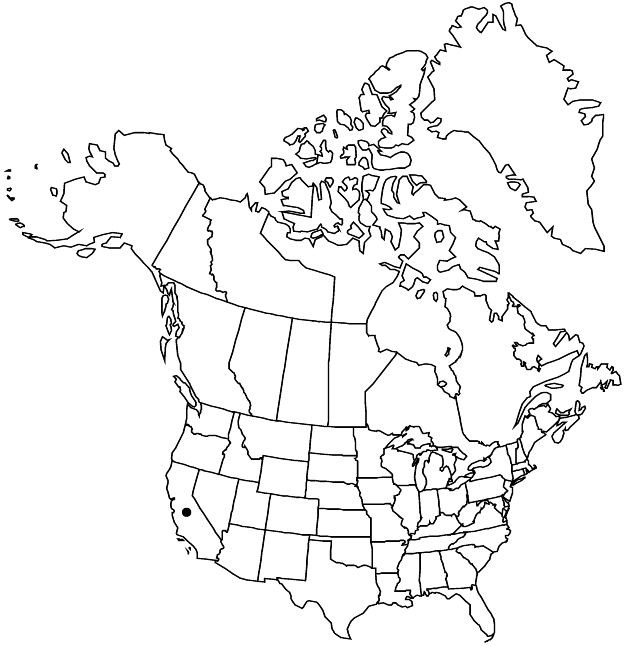Rosa pinetorum
Muhlenbergia 1: 53. 1904.
Subshrubs, forming open colonies. Stems erect, 1–8 (–15) dm, openly branched; bark dark reddish-brown, glabrous; infrastipular prickles single or paired, erect, subulate, 3–10 × 0.5–1.5 mm, base glabrous, internodal prickles dense, smaller, sometimes mixed with aciculi. Leaves (2–) 3.5–7 (–8.5) cm; stipules 5–10 (–30) × 2–5 mm, auricles slightly flared, 1–3 mm, margins entire, sometimes stipitate-glandular, surfaces glabrous, eglandular; petiole and rachis usually with pricklets, glabrous or finely hairy, stipitate-glandular; leaflets 5 (–7), terminal: petiolule 5–12 mm, blade ± elliptic, 12–25 (–32) × 6–15 (–20) mm, membranous to ± leathery, base rounded, sometimes obtuse to cuneate, margins multi-serrate to nearly 1-serrate, teeth (5–) 7–12 per side, acute to obtuse, usually gland-tipped, apex obtuse to rounded, abaxial surfaces ± pale green, glabrous or sparsely hairy, glandular, adaxial green, dull, glabrous. Inflorescences corymbs, 1–5 (+) -flowered. Pedicels erect, mostly slender, 2–20 (–35) mm, glabrous or sparsely hairy, sometimes stipitate-glandular; bracts 1–3, lanceolate or ovatelanceolate, 6–25 × 2–7 mm, margins entire or serrate, short-stipitate-glandular, surfaces glabrous or sparsely pubescent, glandular. Flowers 2–4 cm diam.; hypanthium ovoid to depressed-globose, 3.5–4 × 3.5–4 mm, glabrous, eglandular, neck 0.5 × 2.5–3.5 mm; sepals spreading to reflexed, ovatelanceolate, 7–12 × 3 mm, tip 2–8 × 0.5–2 mm, margins entire or slightly toothed, abaxial surfaces finely hairy, stipitate-glandular, sometimes eglandular; petals single, deep pink, 10–20 × 10–20 mm; carpels 10–40, styles exsert 1.5 mm beyond stylar orifice (1.5–2 mm diam.) of hypanthial disc (3.5–5 mm diam.). Hips scarlet, subglobose to ovoid, 10 × 10–12 mm, fleshy, glabrous, eglandular, neck 1 × 4–5 mm; sepals persistent, erect. Achenes basiparietal, 1–10, pale tan, 3–4 × 2.5–3 mm. 2n = 14.
Phenology: Flowering May–Jun.
Habitat: Seasonally moist areas, openings in pine forests
Elevation: 0–200 m
Discussion
Of conservation concern.
The present circumscription of Rosa pinetorum, restricted to the central California coast, is narrower than that of historical usage (for example, W. L. Jepson 1909–1943, vol. 2; L. Abrams and R. S. Ferris 1923–1960, vol. 2; P. A. Munz 1959), in which the name was applied to dwarf roses throughout the Coast Ranges and Sierra Nevada of California that lacked the conspicuous stipitate hypanthial glands that characterize R. spithamea. Here, the Sierra Nevada populations are treated as R. bridgesii.
Coast Range populations are more problematic; the eglandular characteristic occurs sporadically throughout the range of Rosa spithamea, possibly as a result of hybridization with other species; R. F. Hoover (1966) called such plants forma pinetorum (A. Heller) Hoover. Here, however, the epithet is restricted to relatively uniform populations occurring on coastal terraces in open forests of Pinus muricata and P. radiata on the Monterey Peninsula in central California. Given that these populations are well removed from the nearest known populations of R. spithamea and that Monterey Peninsula has other highly localized endemic species, R. pinetorum is tentatively retained as a distinct species. Plants assigned to this reduced circumscription clustered with R. gymnocarpa in a molecular phylogenetic analysis (A. Bruneau et al. 2007); whether this is indicative of close relationship or introgression is unresolved.
Based on pollen size and shape from the type specimen of Rosa pinetorum, E. W. Erlanson (1931) concluded that it is tetraploid (2n = 28). This is consistent with flow cytometry data, which indicated either triploid or tetraploid status (A. Bruneau et al., unpubl.), but not with chromosome counts using the same plant, which clearly showed a diploid 2n = 14 (D. Zlesak and W. H. Lewis, unpubl.). Erlanson (1934) used the name R. yainacensis to encompass R. pinetorum in the strict sense and putatively tetraploid populations from Fort Ross, California, distinct from the diploid R. calvaria, a synonym of R. bridgesii.
Selected References
None.
Lower Taxa
"dm" is not declared as a valid unit of measurement for this property."dm" is not declared as a valid unit of measurement for this property."dm" is not declared as a valid unit of measurement for this property.

